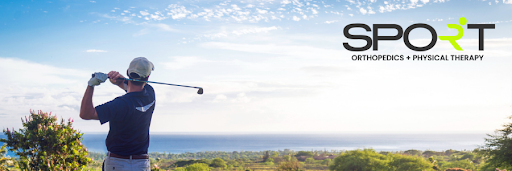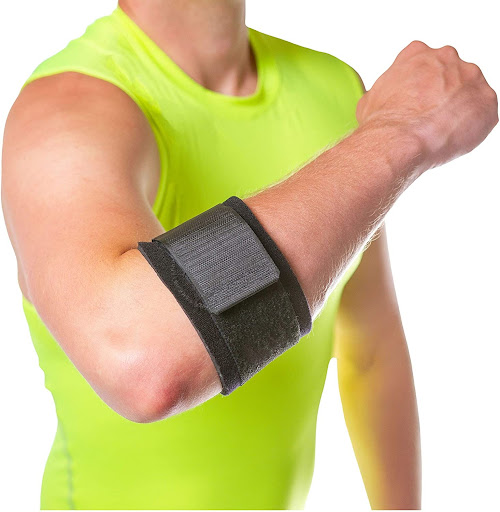Golfer's Elbow Treatment in Frisco & Dallas
Golfer's Elbow Treatment in Dallas
Home » Conditions » Golfer’s Elbow
Golfer's Elbow Treatment in Dallas & Frisco, Texas
Many patients seek tennis elbow treatment in Dallas every year due to its common nature. However, others often don’t realize that they have a slightly different condition: golfer’s elbow. Golfer’s elbow is similar to tennis elbow, but it affects the inside of the elbow rather than the outside. If you’re experiencing persistent elbow pain, call SPORT Orthopedics and Physical Therapy at 469-200-2832. You can also fill out our online intake form to schedule an appointment with the best orthopedic surgeon in Dallas.
What Is Golfers Elbow?
Golfer’s elbow is a disorder in which the tendons of your forearm muscles adhere to a bony lump along the inside of your elbow, resulting in discomfort. It’s possible that the discomfort will move to your forearm and wrist. Sometimes, it can be confused with a UCL tear.
A condition similar to golfer’s elbow is tennis elbow. The main difference between the two is that tennis elbow occurs on the outside of the elbow, while golfer’s elbow occurs on the inside. Golfer’s elbow, however, is not limited just to golfers. Even tennis players who regularly engage their wrists and squeeze their fingers can develop the condition.
Fortunately, golfers elbow treatment tends to be very simple. That means you won’t have to sacrifice too much time away from your hobbies. With enough rest and treatment from a Dallas elbow specialist, you’ll be back on the putting green in no time.

Symptoms of Golfer’s Elbow
Doctors generally identify and diagnose golfer’s elbow based on the following characteristics.
- Tenderness and pain. The discomfort is usually felt on the inside of your elbow, but it can also spread to the inside of your forearm. Certain motions usually make the pain worse.
- Weakness. You will likely experience weakness in the affected hands and wrists.
- Stiffness. People often experience stiffness in the affected area. It sometimes hurts to make a fist.
- Tingling or numbness. These feelings may spread to one or more fingers, most commonly the ring and little fingers.
Golfer’s elbow discomfort might strike abruptly or gradually. Certain motions, such as swinging a golf club, may aggravate the discomfort. We recommend consulting with a Dallas orthopedic specialist if rest, ice, and pain medications are not effective. Seek care immediately if you experience the following.
- The elbow is inflamed and warm to the touch, plus you have a fever.
- You can no longer bend the elbow.
- The elbow looks deformed.
- You think you might have broken a bone.
What Causes Golfers Elbow?
Injury to the muscles and tendons that govern your wrist and fingers causes golfer’s elbow, also known as medial epicondylitis. Excessive or recurrent stress, and particularly strong wrist and finger motions, is usually the cause of the injury. Golfer’s elbow can be caused by incorrect lifting, throwing, or striking, as well as a lack of warm up or inadequate conditioning. Aside from golf, a number of activities can cause golfer’s elbow, including the following.
- Racket sports. Tennis strokes performed incorrectly, particularly the backhand, can result in tendon damage. Excessive topspin, as well as using a racket that is too tiny or heavy, can result in damage.
- Weight training. Lifting weights incorrectly, such as bending the wrists during a biceps workout, can cause the elbow muscles and tendons to get overworked.
- Sports with throwing. Throwing technique in baseball or softball can also be a factor. Golfer’s elbow can also be caused by sports such as football, archery, and javelin throwing.
- Repetitive or forceful work movements. Certain fields, such as plumbing, carpentry, and construction.
In general, people experience golfer’s elbow after performing the activity for more than one hour a day on many occasions.
Risk Factors for Tennis Elbow
Those at higher risk for developing tennis elbow have the following traits.
- Does repetitive activities for around two hours a day
- Aged 40 and older
- Smoker
- Obese
How Long Does Golfers Elbow Last?
Golfer’s elbow takes around three to six months to recover using noninvasive techniques. However, not everyone sees the benefits of this strategy. SPORT Orthopedics and Physical Therapy can assist you if you’ve been doing workouts and other forms of therapy but aren’t seeing results.
How to Sleep With Golfers Elbow
The indications of medial epicondylitis in the elbow react favorably to sleeping postures that keep the arm straight and allow for adequate blood flow to the tendons, which aids in the healing process. Sleeping on your back with your afflicted arm straight down your side is a good option. To hold your body and arm in place, use positioned pillows or bundled blankets. Putting pressure on the afflicted arm should be avoided. This will minimize inflammation and pain in the elbow.
Avoid resting on your afflicted arm or sleeping with your arm raised over your head. Sleeping on the afflicted arm reduces blood flow, and extending the arm overhead might worsen the sports injury. Wear a splint or golfers elbow brace that maintains your arm in a straight position. It acts as a mild reminder of your posture if you have trouble remembering to keep your arm at your side.
How to Improve Golfer’s Elbow at Night
When addressing golfer’s elbow at night, the main objective is to improve blood circulation and release tight muscles. To enhance your sleep and improve discomfort, try these suggestions.
- Compression. Compression is one of the simplest strategies to keep your arm from swelling. Elbow ailments such as golfer’s elbow and tennis elbow, which are closely linked, respond well to mild compression provided by arm sleeves or adaptable braces. Arm sleeves tend to be more relaxing and won’t impede your movement as you sleep.
- Heat. The first thing you should do when you get up each morning is get a heating pad. Warmth will release tight muscles and tendons, allowing you to move more freely and relieve discomfort. For 20 to 30 minutes, lay the heating pad along the inside of your elbow or wrap it around your elbow. To avert skin burns and discomfort, do not sleep with the heating pad on.
- Massages. Massage along the upper and forearm muscles can help to speed up healing and relieve muscular tension. Work your way back up from your wrist to your shoulder, use lengthy movements along the muscles. Avoid massaging firmly on the bone and keep away from inflamed regions. Massage your arm at night to prepare it for sleep and again in the morning to release any tightness.
How to Heal Golfers Elbow
Treatment plans often begin with conservative, non-surgical options. Avoid any activities that cause pain, and apply ice right after you experience pain.
Non-Surgical Treatment
- Medication. You can take a pain medication that is available over-the-counter. Ibuprofen, naproxen sodium, or acetaminophen are all good options. Corticosteroid injections are rarely used since they have not been proven to be helpful over time. Platelet-rich plasma (PRP) is a recent therapy that is being tested. A little amount of your blood is drawn and a concentrated number of platelets and other anti-inflammatory substances are injected into the painful region. More research is needed to determine the efficacy of this therapy.
- Physical therapy. Along with physical therapy in Dallas, we recommend rest, ice to the affected area, a golfers elbow brace, and stretching exercises.
- Gradually return to activities. When your discomfort has subsided, begin practicing your sport or activity’s arm motions. Examine your golf or tennis swing with a coach to guarantee proper technique and make any necessary improvements.
Surgical Treatment
Surgery is rarely required. If your indications and symptoms don’t improve after six to twelve months of conservative therapy, surgery may be a possibility. Elbow arthroscopy is a minimally invasive, camera-guided procedure for removing scar tissue in the tendon pain area. It can also be utilized to heal damaged tissues without the need for extensive, painful incisions.
Rest, ice, and pain medications will help most individuals feel better. Even if you relax and follow the advice for strengthening your arm, the discomfort might last for months or years, due to the severity of your problem. Pain might come back or become chronic at any time.
How to Wear Golfers Elbow Brace
The typical golfer’s elbow brace consists of one elastic strap that loops around the forearm. To support the overworked muscular tendons, the strap usually has a shock-absorbing, neutralizing pressure pad. The strap is secured to the arm with a metal D-ring and Velcro strips, similar to a blood pressure cuff.
Position the upper edge of the band two finger breadths below the fold of your elbow while putting on the brace. The foam cushion should be placed on the inside of the forearm. Return the elastic strap to its original position by slipping it through the D-ring and fastening it against itself. Take care not to over tighten the strap, since this can cut off blood circulation. The idea is to apply hard yet gentle pressure. If you’re confused about your size, measure the broadest area of your forearm and examine the brace’s package for the correct strap size.
Extend your forearm out with your palm up and create a fist to see how effective the brace is. Now try curling your wrist as someone else resists you with your fist. If you feel any discomfort, it’s time to modify the foam pad. Make sure the strap is snug enough to provide support. If the problems persist, adjust the shock-absorbing cushion to the right or left until you reach a location where you can comfortably curl your wrist.

How to Prevent Golfer’s Elbow
There are certain steps that people can take in order to lessen their chance of suffering from golfer’s elbow. We list these below.
- Regularly perform exercises to strengthen the muscles of your forearm. We recommend using light weights or squeezing a tennis ball in your hand. Even the simplest exercises will help.
- Stretch before and after physical activity. Warm up your muscles by walking or jogging for a few minutes. Then, before you start your game, do some moderate stretches.
- Improve your form. Ask a coach or instructor to help you check your form.
- Make use of the appropriate tools. Upgrade to lighter clubs if you’re still using old golf irons. If you play tennis, be sure that your racket is the right size for you. Elbow difficulties might be exacerbated by a racket with a tiny grip or a hefty head.
- While lifting anything, employ the proper technique. Keep your wrists straight and stabilized to reduce the force it’s under.
- Recognize when you need rest. At the first sign of pain or discomfort, take a break. Don’t try to play through the pain.
Contact SPORT Orthopedics and Physical Therapy
Although less common than tennis elbow, golfer’s elbow is nothing to ignore. If left untreated, it has the potential to cause great pain and discomfort, and possibly permanent damage. That’s why we recommend working with an elbow specialist in Dallas. At SPORT Orthopedics and Physical Therapy, we have years of experience treating various elbow conditions, including golfer’s elbow, tennis elbow, and other upper arm pains. To schedule an appointment with an elbow specialist, please call 469-200-2832 or fill out our online intake form.


